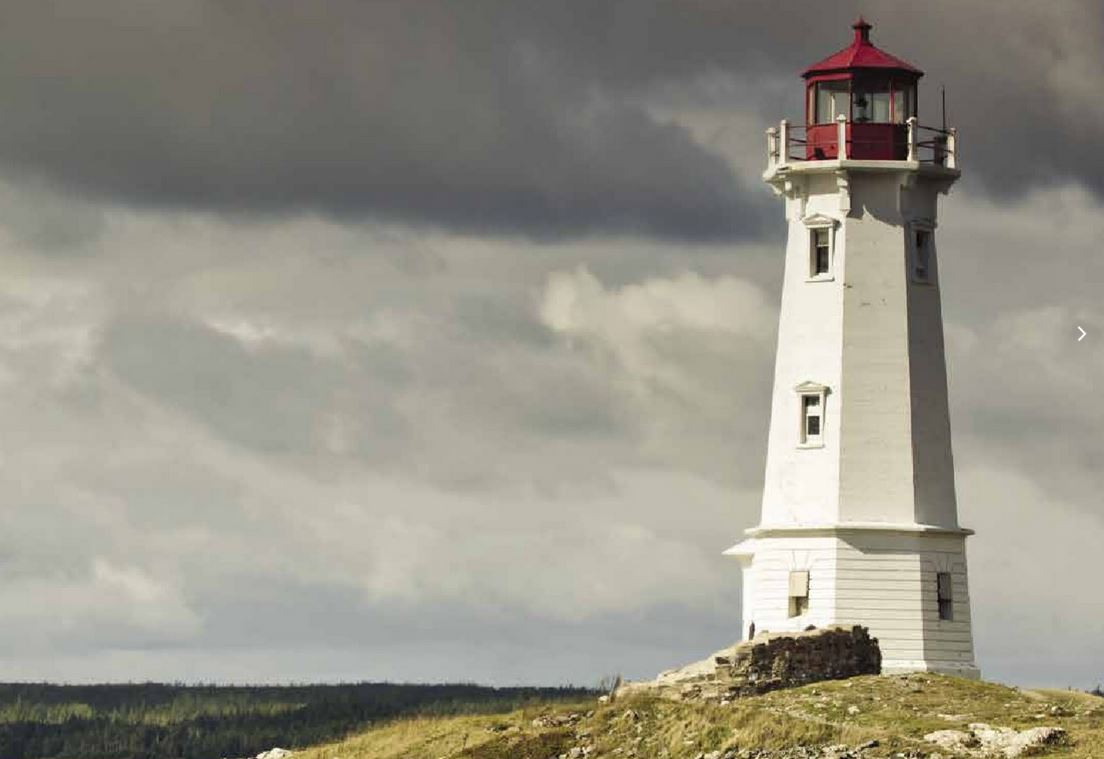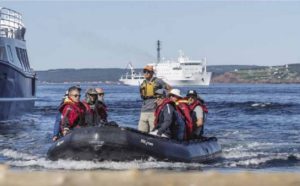Even at 300-metres from the stone ramparts, the Akademik Ioffe is still well within the range of the cannons which loom from the Fortress of Louisbourg. It is from this National Historic Site on the Atlantic Coast of Nova Scotia that we are to begin our seven-day voyage of discovery—not only to learn about the history and cultures along Canada’s East Coast but also to experience some of the region’s best golf courses.
THE BOAT
Our crew hoists our golf gear onto the vessel’s starboard deck masterfully avoiding brightly coloured kayaks and paddleboards. Our goods are now resting adjacent to a flotilla of jet-black Zodiacs, which will soon become our means of “ship to shore” transportation.
Weighing anchor, we sail past the French built, 70-foot tall white circular tower of Canada’s oldest lighthouse, completed in 1734. The beam from the cod liver oiled-fed wicks could be seen from eighteen kilometres away – a welcome beacon for a merchant or naval brigantines navigating the dangerous waters protecting this remote outpost.
As we enter the open waters of the Atlantic and begin our journey around the northern coast of Cape Breton, I take time to explore this long-range polar research ship. From the lounge and bar, which will become the hub of storytelling and Maritime music to the well-stocked library of nature and exploration the vessel is designed for conversation, education and memorable experiences. My cabin is located on Deck 5, the uppermost part of the Akademik Ioffe. Spartan yet comfortable it is furnished with a sofa, writing desk and two single beds a perfect organizing platform for my daily on-shore excursions. The head—a.k.a. Bathroom—is compact and functional and the water always hot for my daily shower.
The journey is titled “Fiddle and Sticks,” a perfect narrative as music and spectacular golf are two of the principal ingredients for my east coast adventure. This is the inaugural golf/exploration voyage for One Ocean Expeditions; a privately owned Canadian company which has become the industry leader in expedition cruising. From the Canadian Arctic to Antarctica, South and Central America to remote islands of the Atlantic Ocean their fleet of three Finnish built ships provide specialized small group experiences in culture, history, wildlife providing spectacular sea and landscapes each and every day.
The success of “Fiddle and Sticks” encouraged the Company to expand this adventure. Utilizing their latest acquisition, the private cruise ship, RCGS Resolute, will commence sailing from Dublin to Edinburgh, in June where passengers will discover the rugged beauty of the land while playing six of the worlds Top 100 golf courses and perhaps enjoy some of the finest whiskeys. Guests, who are not golfers will experience quaint seaside towns, bike rides, hiking and delicious afternoon teas.
One Ocean has been committed to scientific research of the world’s oceans since it’s inception 2500 voyages ago.
In 2014, One Ocean Expeditions was an integral member of the discovery team that found the elusive Franklin Expedition ship HMS Erebus, missing for 150 years, lost on its quest to discover the Northwest Passage.
The Akademik Ioffe is a research ship, so simplicity is the style of dining-room decor: it is an assembly point as tourists mix with international explorers, environmentalists, and scientists, to enjoy a varied menu created daily by respected chefs, representing five nationalities. Every day a delicious homemade soup is offered, from chicken to borscht. Dinners are designed with a touch of international flavour that appeals to every palette. Fish, meat or vegetarian are my choices with a healthy salad bar and tasty desserts. To commence every day a generous buffet breakfast is served to prepare you for the active day ahead.
THE LINKS
Over breakfast this morning, the sense of excitement is infectious for the golfers on board as we are about to experience two of Canada’s most beautiful and stunning golf properties, Cabot Links and Cabot Cliffs. The sound from our ships anchors lowering into the sheltered waters of Inverness’ harbour signals it is time to “suit up” and prepare for the “invasion” to this golf mecca.
Sporting our bright-red waterproof jackets, “Farmer John” pants and calf-high rubber boots, we are fitted with personal flotation devices and approach the gangway. A quick jerk, from a crewmember on our life vest, a thumbs up, and we are given the go-ahead to move forward towards the ship’s steep sloped metal ladder for our descent towards the gently bobbing landing craft.
All members of our group safely secure their positions aboard our 12-passenger inflatable craft. Our approach to the dockside pier is uneventful—though the local lobster fishermen’s weather etched faces show a sense of bemusement at our unique mode of arrival. Disrobing from our confining foul weather gear produces added smirks upon the reveal of a multitude of multihued golf attires.
We gather our gear and board the bus for our short ride to the Rod Whitman designed Cabot Links. Red-capped caddies welcome our arrival, and we tee off with strong winds blowing off the always-in-sight Atlantic. Cape Breton was once a prosperous coal-mining centre, but the last mine closed in the early ’90s. It wasn’t until 2011 did this area begin to show rejuvenation in spirit and prosperity thanks to the opening of Cabot Cliffs Golf Course. On the site of former mine shafts, this links course was ranked in the top forty-five courses in the world by Golf Digest.
A “wee dram” of whisky and a delicious meal following our game at the Glenora Distillery, [recognized as the first single male whisky distilled in ice wine barrels in North America], was a perfect way to end a memorable day.
Our trip back to our ship, under star-filled skies, is magical.
In just one day all of us have become experienced at the art of boarding our vessels and today under Scottish-like weather of mist to heavy rain and wind we arrive at the majestic, Cabot Cliffs. There are few courses in the world that I have played that has created such excitement as this linksland course. Ranked #9 as the best golf courses in the world by Golf Digest and #8 “World’s Most Beautiful Golf Courses,” by Architectural Digest this Crenshaw/Coore design is a must play for every golfer!
Cape Breton, Nova Scotia has been blessed with a topography that has attracted some of the worlds most accomplished golf architects. One of the finest is Canadian, Stanley Thompson involved in the development of 178 courses around the globe. It is here, on the Island’s northeastern shore where he designed Highland Links, seventy-five years ago. From rocky outcrops to ocean views his ability to incorporate the natural beauty of the land produced fairways and greens that are wonderful to observe.
Our voyage now takes us to Canada’s smallest province, Prince Edward Island. Our invading craft literally “hit the beach” by the clubhouse of the Tom McBroom designed, The Links at Crowbush Cove. Recognized by Golf Digest as Canada’s “Best New Golf Course” when it opened its fairways to the public in 1994 this links-style course continues to receive accolades. On another beautiful Maritime day, the course is inspiring as wind-formed sand dunes, the courses emerald green fairways provide a sharp contrast to the Atlantic’s cerulean waters.
THE ISLANDS
It’s not just the uniqueness of our transportation—and the award-winning golf courses—but the chance to visit two remarkable islands which makes this vacation like no other. After sailing waters where dolphin and whale sightings are frequent, we anchor off Iles de la Madeleine, an archipelago composed of a dozen narrow islands in the Gulf of St. Lawrence. Our zodiacs create a grand spectacle when they arrive on the sandy shores of Millerand.
Kayaks, paddleboards and bicycles replace our usual assembly of golf equipment on this trip. We are spending the day enjoying the blue waters of the Gulf of St. Lawrence and cycling the quiet winding roads of this picturesque island, which is part of the province of Quebec.
Over the next two hours, our small group paddles the coastline past Bird Rock, a migratory bird sanctuary where the tiniest of fissures on inaccessible cliffs become nesting sites for many of the 300 varieties of birds that visit these islands. Returning to the beach, we dig into our lunch of local craft beer, seafood and rich cheeses while listening to the upbeat Acadian sounds of our fiddler and mandolin musicians.
For the afternoon we’re offered the opportunity to explore the entire island. A four-hour journey by yellow school buses seems a lot of time to explore such a small island but passing brightly coloured homes, historical sights, and walking red sandstone beaches, we could easily spend more time here.
The final day of our adventure has our ship heading southeast into open Atlantic waters. The fog is thick, and the air smells of seals and salt as we approach the remote shores of Sable Island, a protected 32 km-long strip of sand 330 km southeast of Halifax—a place so secluded and difficult to access that less than 450 visitors are fortunate to visit her shores annually.
We are anchored a kilometre offshore of this Island known by many as the graveyard of the Atlantic. There is no reason to bring our ship closer as the sand and seas are ever changing.
To prepare for our landing, we spray and scrub our outerwear with a multipurpose disinfectant to avoid importing foreign particles to this sensitive land. Once completed, we descend the narrow gangway entering our zodiacs for our 15-minute voyage. Onshore we’re greeted by representatives of Parks Canada; the custodians of the island.
Breaking into small groups, we spend the next three hours exploring mountainous sand dunes, discovering the famous herds of wild horses that have been calling this land home for over two hundred years, the largest colony of grey seals in the world, and flora so beautiful it’s hard to believe that it can survive in such a harsh environment.
Our seven-day voyage has come to an end. Returning to Sydney, Nova Scotia, our group spends our last evening together reflecting on so many memorable moments.
(Published in Westjet Magazine May 2019)












